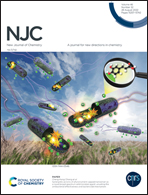RAFT solution copolymerization of styrene and 1,3-butadiene and its application as a tool for block copolymer preparation†
Abstract
For the first time, random copolymers of styrene (St) and 1,3-butadiene (Bd) (poly(Stn-r-Bdm), styrene butadiene rubber, SBR) were successfully prepared via solution reversible addition-fragmentation-transfer (RAFT) polymerization by employing dithio- and trithiocarbonate chain transfer agents (CTAs). The influence of various reaction parameters such as temperature and duration of polymerization, type of CTA, solvent and initiator, on molecular weight, molecular weight distribution (Mw/Mn) and the yield of the copolymers was investigated in detail. Determination of optimal reaction conditions allowed for the successful preparation of linear poly(Stn-r-Bdm) having Mn of up to 26 000 g mol−1 and Mw/Mn ≤ 1.6, with an isolated yield of up to 39 wt%. According to NMR the obtained copolymers were random and did not contain any styrene blocks (more than 5 units in sequence). The composition of poly(St-r-Bd) was found to be nearly independent of reaction conditions and consisted of 19.6–24.0, 15.0–15.5 and 60.5–64.5 wt% of styrene, (1,2)-Bd and (1,4)-Bd units, respectively. The glass transition temperature (Tg) of the copolymers (measured via DSC) varied between −55 and −62 °C, while Tonset (measured via TGA) ranged between 385 and 390 °C. The optimized synthetic method for production of poly(Stn-r-Bdm) copolymers was then extended to produce various poly[Xn-b-(Stm-r-Bdk)] block copolymers, where X represents different methacrylic or styrenic monomeric units. The molecular weight of the poly[Xn-b-(Stm-r-Bdk)] block copolymers was mainly dependent on the molar mass of the starting poly(Xn) macro-CTA and reached as high as 72 000 g mol−1, with the SBR segment varying between 11 800 and 39 600 g mol−1. These materials, believed to be the first of their kind reported in the literature, show clear evidence of nanostructure formation via AFM and promise unique and attractive combinations of stiffness, toughness, thermomechanical performance and chemical reactivity. This work opens up new avenues for the synthesis of novel copolymers with exceptional levels of structural control, thus providing additional tools to the polymer research community as far as the design and creation of materials with new and useful properties is concerned.



 Please wait while we load your content...
Please wait while we load your content...